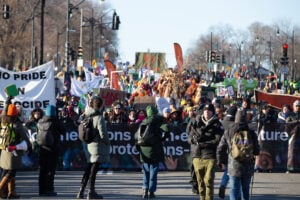
Environment
Inside the fight to protect the Arctic’s “Water Heart”
How the Sahtuto’ine Dene of Déline created the Tsá Tué Biosphere Reserve, the world’s first such UNESCO site managed by an Indigenous community
- 1693 words
- 7 minutes
People & Culture
Launched in 2002, Project Naming invites Canadians to engage in identifying Indigenous people from Library and Archives Canada to help tell the story behind every photograph
In the halls of Canada’s Parliament Buildings, there are portraits of Jacques Cartier, John A. Macdonald, Agnes Macphail, and dozens of other figures from Canada’s history. But there are few images of Indigenous people (in fact, there are more images of dinosaurs in Parliament than there are of Indigenous people). Do some exploring and you will find a handful of photos of Inuit hunters and a solitary portrait of a First Nations man in a headdress appearing to sign a treaty. Unlike their non-Native counterparts, none of the Indigenous people have names. Or, rather, they undoubtedly do have names, but those names aren’t recorded.
The omission of Indigenous names is a problem that is endemic in the telling of Canada’s history — Parliament is just one example. From history books to monuments, non-Native figures are named, while Indigenous people aren’t. Instead they are described as “an Indian”, “a Mohawk”, or some similar demonym. Removing Indigenous names removes Indigenous agency from Canada’s history. Without names, history is reduced to anthropology; instead of a shared national consciousness, the ties that could bind us together are relegated to dusty archives and dustier academics.
However, a few metres down Wellington Street at Library and Archives Canada headquarters, there are people in government who are trying to fix this problem through a program known as “Project Naming.”
Celebrating its 20th anniversary this year, Project Naming invites Canadians to help identify the many Indigenous people whose names were left off archival photos in Library and Archives Canada’s collection. The project began with an exclusive focus on Nunavut, but in recent years has expanded to include all of Canada. Project Naming involves digitizing photos — about one to two per cent of the total collection — and posting them to the department’s Facebook page, where people can identify them and, hopefully, provide names to the nameless Indigenous people. Facebook might seem an unusual place to do this important work, but the platform remains the unrivalled town square for Indigenous people.
Paul Seesequasis, a Willow Cree activist who has created his own naming campaign on Facebook, says part of the importance of naming is that it isn’t the end of the story. It leads people “to share the stories behind that photo — what was happening in the community at that time.”
Beth Greenhorn, a senior project manager in the public services branch at Library and Archives Canada, saw a similar phenomenon with Project Naming’s work. “Many of the [Inuit] youth have lost their first language, and there was this huge generational barrier,” she says. “So many of the younger Inuit were intimidated, and it was kind of a scary experience talking to their elders. But having a photo was really a way to kickstart a discussion.”
This discussion is one that all Canadians should participate in. More Indigenous faces and names in Parliament and elsewhere can help non-Natives overcome their fear or shame about engaging with the country’s true history.
Since 2002, about 10,000 images have been digitized, and several thousand Inuit, First Nations and the Métis Nation individuals, activities and places have been identified. As part of its project’s expanded focus, Library and Archives Canada also invites Indigenous representatives to come to Ottawa to inspect the other 98 per cent of the collection that’s not yet digitized.
“This is the most rewarding part — when you can actually sit with somebody, a family or an individual, and go through material,” says Greenhorn. “It’s not uncommon that they find somebody that they know — or even themselves.”
To participate in Project Naming at Library and Archives Canada’s office in Ottawa, Indigenous representatives should contact the project in advance at [email protected].










This story is from the September/October 2022 Issue

Environment
How the Sahtuto’ine Dene of Déline created the Tsá Tué Biosphere Reserve, the world’s first such UNESCO site managed by an Indigenous community

Science & Tech
Celebrating Canadian Innovation Week 2023 by spotlighting the people and organizations designing a better future

History
A look back at the early years of the 350-year-old institution that once claimed a vast portion of the globe

People & Culture
Indigenous knowledge allowed ecosystems to thrive for millennia — and now it’s finally being recognized as integral in solving the world’s biodiversity crisis. What part did it play in COP15?